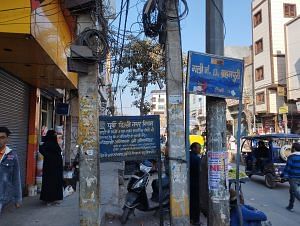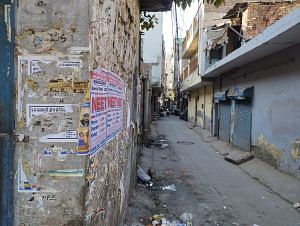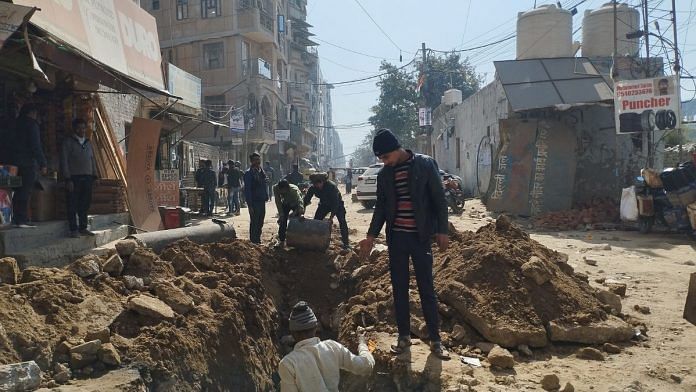New Delhi: Giant iron gates have been erected on every street in North East Delhi’s Karawal Nagar, Shiv Vihar and Seelampur areas. Three years after the Delhi riots killed 53 people here, the fear of unknown attackers coming from outside is still alive. But the scarred neighbourhoods are changing in other, more fundamental ways too.
Hindu and Muslim residents are fleeing mixed colonies. They are selling their houses and moving to other areas of their community, looking for security.
The riots lasted for six days. Marauding mobs attacked residents, burnt shops and homes while neighbours turned on each other.
Some lost their jobs when they shifted after the violence; others abandoned theirs to return to their hometowns. Those who remained are looking for safety in the numbers of their own people.
Hindus and Muslims here had co-existed peacefully since the 1992 violence first disturbed the area. But one bout of rioting in 2020 eroded this fragile 28-year trust. The move to segregate is also ghettoising them into single-religion neighbourhoods, creating more room for suspicion and stereotypes about the unknowable other.
Manoj Kumar, 53, a mechanic, used to live in a mixed-faith area of Brahmpuri before selling his house and moving to East Gorakh Park, a Hindu-dominated area of Shahdara located a couple of kilometres from Brahmpuri. It’s a tiny flat, not an independent house, but he is relieved that all the neighbours are Hindus.
“We didn’t want to sell the house, but the atmosphere in that area was getting worse by the day,” Kumar said. “After the riots, Muslims from outside started coming to that area, and we were not able to trust them,” he added.
Brahmpuri did not suffer during the rioting and was regarded as an island of Hindu-Muslim harmony. But it was close to some of the worst-affected areas, and fear travels well. Then last month, some posters were put up on its streets, from Gali no. 13 to Gali no. 6, urging Hindu landlords not to sell their houses to Muslim buyers.

The posters were signed by lawyer Pradeep Kumar, who works at Karkardooma Court. But he denied any association with them. That said, he did agree with the sentiment on the posters.
“Wherever there are more Muslims, there is an atmosphere of fear. Wherever they live, that area gets criminalised,” said Kumar. He lives in Brahmpuri as well, and has observed the flight of Hindu families from the neighbourhood. “Everyone wants to live in a safe place where there are no Muslims,” he added.

Also read:
Fear, distrust loom
The exhortation on the posters is already playing out. Property dealers and landlords are adding to the climate of fear and distrust.
Hussain’s family stays in Yamuna Vihar, a Hindu-dominated area with just four Muslim families. Her own home is the only Muslim family in the apartment block. They have been planning to buy a house in the residential complexes nearby but are hitting a roadblock.
“When we spoke to the property dealer, he said we can no longer get a house near this area. He told us that we would have to live in a Muslim locality like Vijay Park,” said 26-year-old Hussain.
At first, this seemed odd to Hussain, but over time, she resigned herself to the idea. And then there’s this nagging feeling about the safety of her family should the simmering communal tension spill onto the streets again.
“The rise of hate speech has made the atmosphere tense. The 2020 riots broke out due to these speeches, and it is possible that such riots will also happen in the future,” she added.
Her building block overlooks a busy road. There are always people milling about, and stores are open till late at night, but the certainty of security has disappeared. She and her sisters no longer feel safe.
“No one is willing to talk to us in this area. So it doesn’t make sense to stay here anymore.”
Also read:
The beginning of ghettoisation
With each incident of Hindu-Muslim riots, Indian cities move increasingly toward segregation. Cities like Mumbai, Ahmedabad and Kanpur have been affected by successive waves of riots over seven decades, and the two communities have moved further apart.
Discrimination based on religion was always prevalent. Dr Mohsin Alam Bhat, a professor at O. P. Jindal Global University who investigated rental house discrimination against Muslims in Mumbai and Delhi between 2017 and 2019, discovered that it was “neither localised nor episodic, but deeply systemic.”
He found that when they weren’t rejecting Muslim tenants outright, brokers would subtly steer them to Muslim–concentrated neighbourhoods. A broker in Malviya Nagar confirmed this to Alam and his team of researchers; he actively told Muslim house hunters that he didn’t have any units. He didn’t want the hassle. Another broker from Inderlok said he would find units for tenants “based on their names”.
French political scientist Christophe Jaffrelot, who has written extensively on the displacement of Muslims and the rise of ghettoisation, expands on this in his article, In, and Out, of the Ghetto. Some cities have witnessed so many “frequent and devastating” riots that Muslims have started to live in the same locality.
“They know that arsonists generally attack Muslims when they live in small, isolated pockets. They then form ghettos, which combine the features of enclaves and of slums,” he writes.
Jaffrelot, along with fellow political scientist Laurent Gayer, has also authored Muslims in Indian Cities: Trajectories of Marginalisation, a book that talks about the socio-economic decline of urban Muslims due to rising communal disharmony.
This could well be the future for Hussain and her family. In Contested Homelands: Politics of Space and Identity, author Nazima Parveen calls the act of moving to such localities a “compulsion” for Muslims.
“The community is now forced to live in pockets where Muslims dominate. They are also not being allowed to stay in other areas,” Parveen told ThePrint.
Mohammad’s life was turned upside down hours after the riots broke out. The 43-year-old grocery shop owner had been renting a house in C Block, Janakpuri, a Hindu-dominated area, for 12 years.
“A few hours after the Delhi riots broke out, the landlord asked me to vacate his house. He said that this was a ‘Hindu area’ and that it was not right for me to live there. They told me to go to ‘my locality’ [dominated by Muslims],” recalled Mohammad. His biggest sorrow is that he is no longer in touch with any of his old Hindu friends.
It’s not always forced, though. Gayer’s research in Delhi’s Abul Fazal Enclave shows that a majority of Muslim families choose to live here. Jaffrelot, too, acknowledged that there are enclaves born out of “Muslims’ desire not to mix with others in order to protect their identity in a process of self-segregation”.
Also read:
Property rates peak
In riot-affected areas, people are selling their houses at low prices. On the other hand, property rates and rents have increased manifold in single-faith residential areas.
“Because people have started migrating, the demand has increased by 20 to 30 per cent. A room earlier available for Rs 5,000 is now rented out for Rs 10,000,” Rashid Ali, a property dealer from Mustafabad, told ThePrint.
The same trend plays out in Jamia Nagar and North East Delhi’s areas, where vacant spaces are getting filled quickly.
“I was renting a big house in Janakpuri for Rs 4,500, but here in Shaheen Bagh, I am living in two small flats by paying more than Rs 7,000 a month,” said Mohammad.
Additional floors are being built to meet the demand. New buildings are being constructed hastily in the few Muslim-majority areas in Delhi. “People are being forced to live here at high prices without basic facilities,” said Mohammad Asif, Resident Welfare Association president of Abul Fazal Enclave’s A and D blocks.
There is a lack of basic amenities in such colonies, and the fear of bulldozers also sneaks around.
For now, the only thing they can do is fortress up. Iron gates have become the norm. “Today, people have to depend on these gates for security, which the police should have ideally provided,” said Asif Mujtaba, chairman of Shaheen Bagh-based NGO Miles2Smile, which works to empower people in need and was founded in the aftermath of the North East Delhi riots.
The iron gates at the ends of the streets are growing taller. Mujtaba agrees.
“These gates represent the failure of the State.”
(Edited by Zoya Bhatti)



